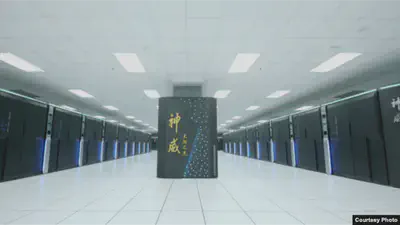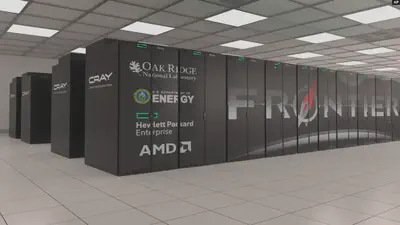Who is the strongest computer in the world? Why is China leading the world in supercomputers, but why is it secretive?

Translated by Google.

WASHINGTON — The US supercomputer Frontier topped the global supercomputing speed test earlier this year. However, there are reports that at least two Chinese supercomputers have surpassed their American counterparts in speed, but refused to participate in the world competition. Some analysts say that China does not want to disclose the details of its supercomputing system to the public, perhaps because it is afraid that it will be sanctioned by the United States. In addition, whether Chinese supercomputers use TSMC chips has also become a matter of concern to the industry.
The US “frontier” supercomputing list tops the list , but China already has a secret weapon?
The super speed of 10 billion billion calculations per second has always been the goal of the supercomputer field. Supercomputers that can reach this threshold of computing power are called “exascale” supercomputers. On May 30 this year, the American supercomputer system “Frontier” topped the “TOP500” list of the world’s top 500 supercomputers with a speed of 11.02 billion operations per second. “TOP500” is regarded by the industry as one of the authoritative evaluations of supercomputing computing power.
The Top500 list was first published in 1993. Jack J. Dongarra, Distinguished Professor of Electrical Engineering and Computer Science at the University of Tennessee, is the designer of the Top500 benchmark. “In a sense, the top 500 people have acquired a kind of proud capital. Now, this proud capital is obtained by the cutting-edge supercomputer at Oak Ridge National Laboratory,” Dongarra told VOA.
“Countries with the fastest supercomputers can in a sense do the best science and simulations, leading to scientific discoveries and discoveries of new things,” he said.
China has been catching up in the field of supercomputers in recent decades. From 2010 to 2019, China’s supercomputer ranked first in the 20th TOP500 list 11 times. Although the speed champion in recent years has been taken by American computers, Chinese products account for the largest share in terms of the number of supercomputers that have entered the top 500.

Although “Frontier” is the fastest supercomputer in the official Top500 evaluation, some industry insiders believe that China has designed at least two E-class supercomputers, and the computing power even exceeds that of “Frontier” - “Tianhe-3” and “Shenwei” “The system’s new product OceanLight (“Ocean Light”).
The American technology media The Next Platform was the first to report that China is running two E-class supercomputers. Among them, “Sunway Ocean Light” inherits the “Sunway Taihu Light” system, with a peak performance of 1.3 billion per second. 100 million times, higher than the top American “Frontier” in this Top500 list.
The designer of the Top500 list, Tangalla, said that the designers of “Light of the Sea” and “Tianhe No. 3” chose not to participate in the evaluation, which made the outside world feel “a bit mysterious”. He said it may have something to do with the designer’s desire to conceal the origin of the chips for the two supercomputers.
He said: “There is speculation that they are not on the list, maybe because it may reveal some information about where these chips are made. So, we believe that these chips may be made by TSMC in Taiwan.”
“The U.S. makes chips in Taiwan, and many countries make computer chips there. My guess is that the Chinese also use TSMC to make chips — chips designed in China but made in Taiwan,” he said. “If China publishes these The real performance of supercomputers, the U.S. may take some action against TSMC to prevent them from producing chips for China.”
Is it counterproductive to restrict China’s supercomputing by the US entity list?
China used to rely on U.S. companies such as Intel and Nvidia to design and manufacture supercomputers, but starting in 2015, the path has narrowed due to U.S. sanctions.
The U.S. added China’s National University of Defense Technology, Changsha National Supercomputing Center, Guangzhou National Supercomputing Center, and Tianjin National Supercomputing Center (the designer of the “Tianhe System”) to the Entity List in 2015. In June 2019, the United States included Sugon, Haiguang, Chengdu Haiguang, Chengdu Haiguang Microelectronics Technology and Jiangnan Institute of Computing Technology on the entity list; April 8, 2021, including Tianjin Feiteng Information Technology Company, Shanghai Integrated Circuit Technology Chinese supercomputing research institutions, including the Industry Promotion Center, Sunway Microelectronics, the National Supercomputing Jinan Center, the National Supercomputing Shenzhen Center, the National Supercomputing Wuxi Center, and the National Supercomputing Zhengzhou Center, were also blacklisted by the United States. Chinese entities on the Entity List must be chartered by the U.S. government to do business with U.S. companies.
The Biden administration of the United States introduced new restrictions at the end of August this year, restricting Nvidia and Advanced Micro Devices (AMD) from exporting high-end GPU chips to China and Russia. Such chips are widely used in supercomputers. Nvidia said the new restrictions affect the existing product A100, as well as the H100, which is expected to be available later this year.
Douglas Fuller, an associate professor at Copenhagen Business School, told VOA that U.S. sanctions against China are becoming increasingly targeted.
“They (export controls) are fairly narrow and well-targeted…because (the U.S. government) doesn’t want AI chips going into the military,” he said in an email.
U.S. technology export controls have slowed the development of certain supercomputing systems in China to a certain extent, but some analysts believe that such a chip control strategy is only temporary in restricting the development of Chinese supercomputers.
Dongarra, a distinguished professor at the University of Tennessee, said China’s lack of access to U.S. chip hardware has created software challenges for supercomputing designers.
He said: “One of the disturbances (for China) to feel is that, for example, the applications that were running on the previous generation of Chinese high-performance computers based on Western technology had to be rewritten based on the software running on the new machines. Writing software can be a huge challenge.”
“It may take a lot of time, but I think the Chinese are very capable of doing this conversion, converting algorithms into software that can run on Chinese machines.”
David Bader, Distinguished Professor of New Jersey Institute of Technology and Director of the Institute of Data Science, gave an example of “Dawning”, one of China’s three major supercomputing systems, that China chose to independently adjust the technical integration of domestic processors after the US sanctions. and succeed.
“The U.S. restrictions definitely had some impact on Dawning,” Bader told VOA: “However, instead of using Intel, they used Hygon x86 processors and Hygon DCU accelerators instead of Nvidia GPUs, So they have been using technology to consider integrating domestic CPUs and GPUs. It can be said that this underlying technology is still based on American technology, such as the x86 core, but now China can manufacture its own chips independently of American companies and chipsets.”
“So, in the past, U.S. sanctions have accelerated China’s development of its own supercomputing technology… So I believe that today’s restrictions on… Nvidia and Supermicro GPU accelerators, targeting China and Russia, etc., will lead to China’s Further development of new capabilities beyond current technology.”
What exactly is a supercomputer useful for?
Experts say high-performance computing (HPC)-based simulation experiments are a direct driver of modern scientific research. “We often think that science is done by performing physical experiments on theoretical results. Today, we augment scientific research with computational simulations that we develop. Simulations are helping us understand things that were previously incomprehensible,” Dongarra said.
“It’s often said that the people who have the fastest supercomputers can do the best science,” he said. “It’s because with these fast supercomputers, you can get more accuracy in computational analysis, and you can compute faster. quick.”
Take the “Frontier” supercomputer in the United States as an example. According to the “Wall Street Journal”, “Frontier” was used to analyze 11 million genomes to better distinguish and predict virus mutations.
“It gives us clues to develop the next generation of vaccines and therapies to not only treat and prevent Covid-19, but other types of disease,” Oak Ridge National Laboratory director Thomas Zacharia told The Wall Street Journal.
According to the report, Oak Ridge National Laboratory allows scientists from around the world to use “leading edge” supercomputers based on the value of the research, and requires scientists who use the supercomputer to request the publication of their research results.
China says scientists from other countries are welcome to use Tianhe-3 for research, but so far the Chinese supercomputer has only been used by Chinese government-backed scientific institutions.
Supercomputers can be used for weapons development and intelligence gathering. The New York Times said that some of China’s giant computer systems are believed to be used to monitor Muslim minority groups such as the Uighurs in Xinjiang, and artificial intelligence technology is increasingly being used in facial recognition to enhance social surveillance.
“It’s important to be the leading country, because, as people say, ’to outcompute is to outcompete,’” Bader said. “So for national competitiveness, the U.S. dominates the calculations and data science fundamentals, which is very important.”
谁是世界最强电脑?中国超算世界领先却为何遮遮掩掩
2022年9月9日 09:13
许宁

华盛顿 – 美国超级计算机“前沿”(Frontier)今年早些时候登上全球超算速度评测榜首。不过,有报道说,中国至少有两台超级计算机在速度上已经超过美国对手,但拒绝参与世界评比。有分析说,中国不想将其超算系统细节公之于众,可能是怕“树大招风”再招美国制裁。另外,中国超算是否使用了台积电芯片也成为业界关注的问题。
美国“前沿”超算榜单拔头筹 但中国早有秘密武器?
每秒钟进行一百亿亿次计算的超级速度,一直是超级计算机领域试图突破的目标。能达到这个运算能力门槛的超级计算机被称为“E级”(exascale)超算。今年5月30日,美国巨型计算机系统 “前沿”(Frontier) 以每秒110.2亿亿次的运算速度登上全球超级计算机500强榜单“TOP500”之首。“TOP500”被业界认为是超算计算能力的权威评测之一。
Top500榜单1993年首次公布排名。美国田纳西大学电气工程和计算机科学杰出教授杰克·唐加拉(Jack J. Dongarra)是Top500评测标准的设计者。唐加拉对美国之音说,“从某种意义上说,Top500排名第一的人获得了一种自豪的资本。现在,这个自豪的资本由橡树岭国家实验室的前沿超级计算机获得。”
他说:“拥有最快超级计算机的国家在某种意义上可以从事最好的科学和模拟,从而致使科学发现和新事物的发现。”
中国近几十年在超级计算机领域奋起直追。2010年到2019年,中国超算在20届TOP500榜单评选上11次排名第一。近几年的速度冠军虽然由美国计算机摘取,但从进入前500名超级计算机的数量来看,中国产品所占最多。

虽然“前沿”是Top500官方评测的最快超算,但一些业界人士认为,中国已经设计出至少两款E级超级计算机,运算能力甚至超过了“前沿”——“天河三号”和“神威”系统的新产品OceanLight(“海洋之光”)。
美国科技媒体The Next Platform此前率先报道说,中国正在运行这两台E级超算,其中 ,“神威·海洋之光”继承了“神威·太湖之光”系统,峰值性能达到每秒1.3百亿亿次,高于本次Top500榜单排名第一的美国“前沿”。
Top500榜单设计者唐加拉说,“海洋之光”和“天河三号”的设计者选择不参加评测,让外界感到“有点神秘”。他说,这可能与设计者希望隐瞒这两款超算的芯片产地有关。
他说:“有人猜测,它们不在榜单上,可能因为这样可能会透露一些关于这些芯片制造地的信息。所以,我们相信这些芯片可能是台积电在台湾制造的。”
“美国在台湾制造芯片,许多国家在那里制造计算机芯片。我的猜测是,中国人也用台积电来制造芯片——芯片在中国设计,但在台湾制造。”他说:“如果中国公布了这些超级计算机的真实性能,美国可能会对台积电采取一些行动,阻止他们为中国生产芯片。”
美国实体清单制约中国超算适得其反?##
中国过去依赖美国英特尔(Intel)和英伟达(Nvidia)等公司设计和制造超级计算机,但从2015年开始,由于美国制裁,这条路变得越来越窄。
美国于2015年将中国国防科技大学、长沙国家超级计算中心、广州国家超级计算中心和天津国家超级计算中心(“天河系统”的设计者)列入实体清单。2019年6月,美国将中科曙光、海光、成都海光、成都海光微电子技术和江南计算技术研究所列入实体清单;2021年4月8日,包括天津飞腾信息技术公司、上海集成电路技术与产业促进中心、Sunway Microelectronics、国家超级计算济南中心、国家超级计算深圳中心、国家超级计算无锡中心以及国家超级计算郑州中心在内的中国超算研究机构也被美国列入黑名单。实体清单上的中国机构必须获得美国政府的特许才能与美国公司开展业务。
美国拜登政府今年8月底出台新的限制,限制英伟达和超微半导体公司(AMD)向中俄两国出口GPU高端芯片。这类芯片被广泛用于超级计算机中。英伟达方面表示,新的限制令影响了现有产品A100,以及预计将于今年晚些时候上市的产品H100。
哥本哈根商学院副教授傅道格(Douglas Fuller)对美国之音说,美国针对中国的制裁正越来越具有针对性。
他通过一封电子邮件中说:“它们(出口管制)范围相当狭窄,目标明确……因为(美国政府)不希望人工智能芯片进入军方。”
美国的技术出口管制一定程度上放缓了中国某些超算系统的发展,但一些分析人士认为,这样的芯片管制策略对制约中国超级计算机的发展只是暂时性的。
田纳西大学杰出教授唐加拉说,中国无法获取美国的芯片硬件,这给超算设计者带来了软件方面的难题。
他说:“(让中国)感受到的一种干扰是,比方说,上一代基于西方技术的中国高性能计算机上运行的应用程序,必须根据新机器上运行的软件重新编写这些应用程序。重新编写软件可能是一个巨大的挑战。”
“这可能需要很多时间,但我觉得中国人很有能力进行这种转换,将算法转换成到中国机器上可以运行的软件。”
新泽西理工学院杰出教授、数据科学研究所主任戴维·巴德(David Bader)以中国三大超算系统之一“曙光”举例说,中国在美国制裁后选择自主调整国产处理器的技术整合,并取得成功。
“美国的限制肯定对‘曙光’产生了一定影响。”巴德对美国之音说:“不过,他们不使用英特尔,而是使用了海光x86处理器和海光DCU加速器,而不是英伟达的GPU,因此他们一直在利用技术,来考虑整合国产CPU和GPU。可以说,这一底层技术仍基于美国技术,例如x86核心,但现在中国能够独立于美国企业和芯片组,制造自己的芯片。”
他说:“因此,在过去,美国的制裁加速了中国发展自己的超级计算技术……因此,我相信,今天对……英伟达和超微GPU加速器的限制,针对中国和俄罗斯等,将导致中国进一步发展超越当前技术的新能力。”
超级计算机究竟有什么用?
专家说,基于而高性能计算(HPC)的模拟实验是现代科技研究的直接驱动力。唐加拉说:“我们常常以为科学是通过对理论结果进行物理实验来完成的。今天,我们用我们开发的计算模拟来增强科研。模拟正在帮助我们理解以前无法理解的东西。
他说:“人们常说,拥有最快超级计算机的人可以做最好的科学。这是因为有了这些快速的超级计算机,你可以在计算解析中获得更高的准确性,并且计算速度更快。”
以美国“前沿”超算为例,据《华尔街日报》报道,“前沿”被用于分析1100万个基因组,以更好地区分和预测病毒变异。
橡树岭国家实验室总监托马斯·扎卡利亚(Thomas Zacharia) 对《华尔街日报》说:“它为我们提供了开发下一代疫苗和疗法的线索,不仅可以治疗和预防新冠,还可以治疗其他类型的疾病。”
报道说,橡树岭国家实验室根据研究的价值,允许来自世界各地的科学家使用“前沿”超级计算机,并要求使用这台超算的科学家要求发表他们的研究结果。
中国表示,欢迎其他国家的科学家使用“天河三号”进行研究,但迄今为止,这台中国超算仅由中国政府支持的科学机构使用。
超级计算机可被应用于武器开发和情报收集等方面。《纽约时报》说,中国的一些巨型计算机系统据信用于监视新疆维吾尔人等穆斯林少数民族群体,人工智能技术也越来越多地应用于人脸识别,强化社会监视。
巴德说:“成为领先的国家十分重要。因为正如人们所说的,‘要算过对手才能竞争过对手’(to outcompute is to outcompete)。因此,对于国家竞争力来说,美国要主导计算和数据科学基础,这非常重要。”
https://www.voachinese.com/a/us-china-supercomputer-20220908/6737627.html